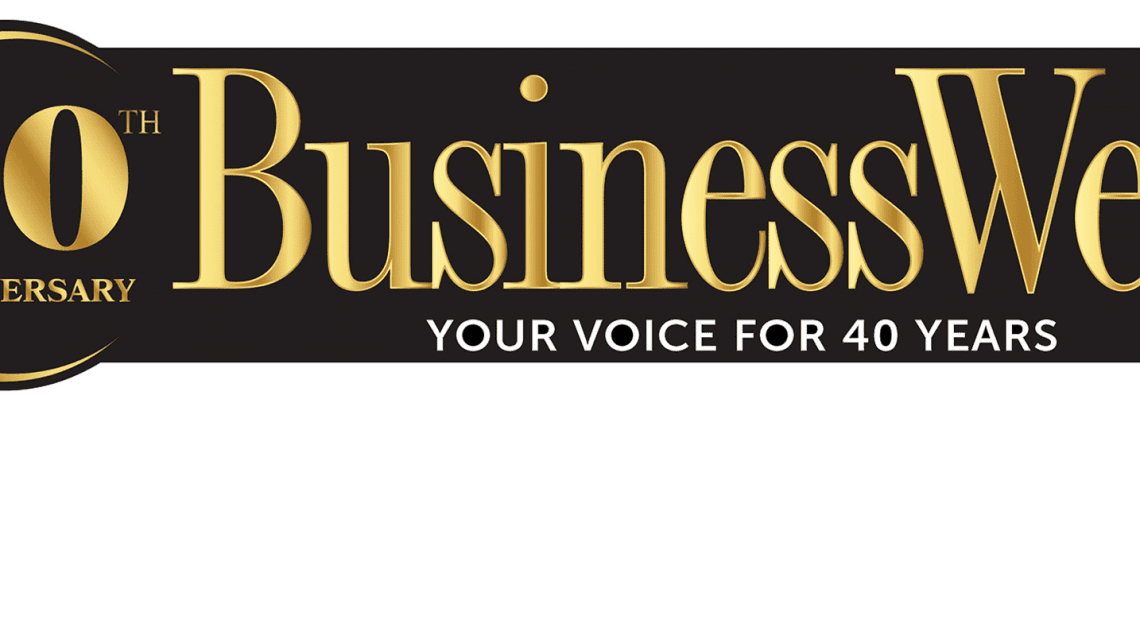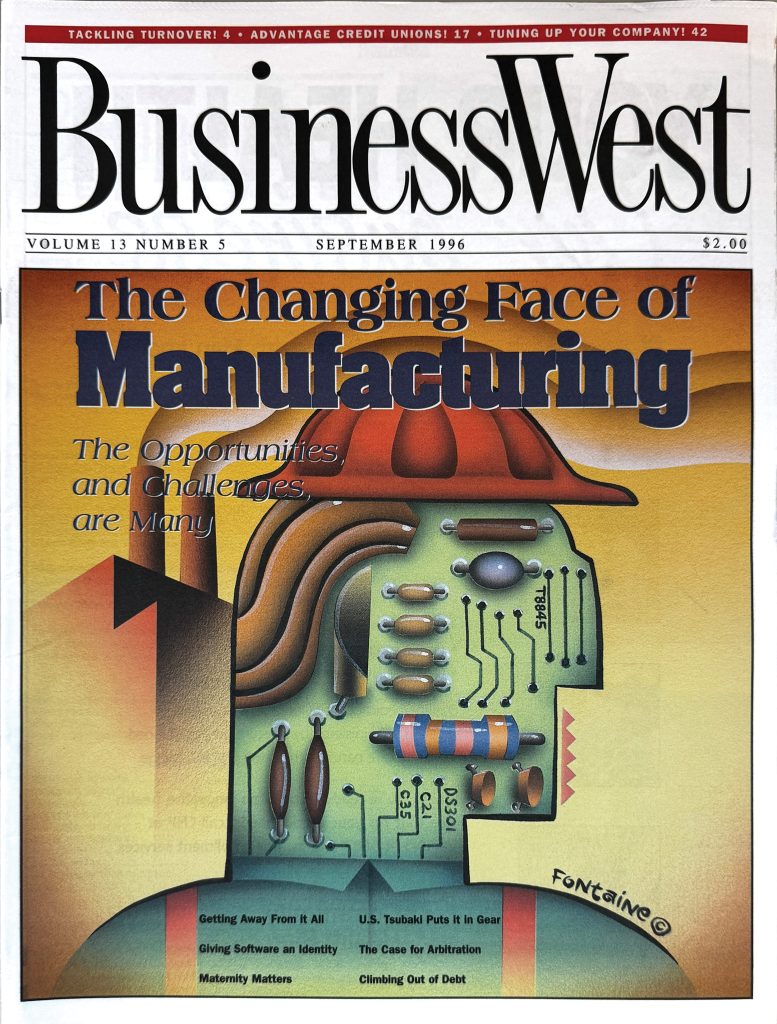
40 Years of Manufacturing
Companies Still Find Ways to Make It Here
 Rick Sullivan calls manufacturing the “invisible backbone” of the Western Mass. economy.
Rick Sullivan calls manufacturing the “invisible backbone” of the Western Mass. economy.
That’s not an adjective he would likely have used 40 years ago, not when the region and many of its communities were dominated by large individual manufacturers or clusters — like GE’s massive transformer complex in Pittsfield, American Bosch and other major players in Springfield, and a still-sizable paper-making sector in Holyoke.
But it works today.
Indeed, while there are still some large manufacturers employing hundreds of people (as opposed to thousands 40, 50, or 100 years ago), this sector is now dominated by smaller players employing maybe a few dozen people each.
And what they’re making has changed as well. While local manufacturing was dominated by firms making tires, matches, paper, and, before that, arms for the U.S. military (at the Springfield Armory) and even monkey wrenches and ice skates, today, they’re making parts for stealth fighters, infrared goggles, medical devices, and other sophisticated products. And soon, in Holyoke, one will be making what is billed as ‘green’ concrete.
“I say invisible backbone because the manufacturing sector in Western Mass., for the most part, is made up of small- to mid-sized manufacturers that are in the supply chains of the larger companies,” said Sullivan, president and CEO of the Western Massachusetts Economic Development Council and formerly the long-time mayor of Westfield, one of the region’s manufacturing hubs. “And many of those companies are not situated in Western Mass. or Massachusetts, for that matter; they’re in Connecticut or worldwide.
“And they make important parts for the industry,” he went on. “Back when I was mayor of Westfield, there was $100,000 worth of parts of on every single commercial airplane that went through the city of Westfield, and that has only increased.”
These are some of the shifts that have come to this important sector over the past four decades. Others include a seismic shift in how such jobs are perceived, one that has contributed to a lingering workforce problem, and one that has led to a sea change in how hard companies must work to attract and retain talent — and some initiatives that probably couldn’t have been imagined 40 years ago.
Like ‘Barbecue Friday’ at Boulevard Machine in Westfield.
Susan Kasa, president of that company, which makes parts for the military, aerospace, and outer space, among other sectors, said Boulevard feeds its workers breakfast and lunch each day, and, as that name suggests, it devotes Fridays to barbecuing.
“People will take turns being the chef,” she explained. “We’ll do a lot of hot dogs and hamburgers, but sometimes we’ll go all out and do chicken and other meats; our people really enjoy it. You know it’s Friday because you can smell the barbecue.”
Rick Sullivan
“I say invisible backbone because the manufacturing sector in Western Mass., for the most part, is made up of small- to mid-sized manufacturers that are in the supply chains of the larger companies.”
This new tradition is one of many efforts that fall in the broad category of attracting and retaining talent, she said, with others including everything from advertising open positions in church bulletins to programs to introduce young students to manufacturing and the opportunities in this field — starting with middle school.
“We’re not your grandfather’s shop,” Kasa said, adding that the machinery is both more complex and cleaner, and one ongoing challenge is educating not only young people but their parents about this new reality.
Mark Borsari agreed.
He’s president of Sanderson MacLeod, a Palmer-based maker of twisted wire brushes. That’s not as sophisticated a product as infrared goggles or parts for artificial knees, but is an example of how traditional manufacturing is still making it in Western Mass., although it’s challenging — when it comes to everything from competition for orders to competition for people.
“It’s a different world, a different environment than it was 40 years ago and even 20 years ago,” Borsari said. “It gets down to the perception people have and the pride people have in making things and the importance of community; it’s just different.”
Susan Kasa
“Young people have such a bright future in manufacturing, and without incurring all that college debt.”
Like others we spoke with, he said technology, automation, and lights-out manufacturing, where machines run unattended at night, will play ever-larger roles in this sector. But it will always need people, and finding them will continue to be a challenge, especially as the Baby Boomers continue to retire in large numbers.
Tradition of Innovation
As he talked about this important sector, Sullivan stressed what hasn’t changed in 40 years or 250 years, and hopefully won’t change moving forward — that manufacturing is a source of what economic-development leaders have long called ‘good jobs at good wages.’
That is, the kind of jobs every region and every community wants and compete tooth and nail to get — and retain.
This region has always had a strong tradition of manufacturing and innovation — Sullivan said those words are essentially interchangeable — that goes back to the Springfield Armory and even before that. And it continued with the production of everything from firearms to toys; from automobiles and trolley cars to textiles; from home appliances to buggy whips, products that even gave some area communities their nicknames.
Many of these items are no longer made here (although trolley cars are again with the arrival of CRRC). In their place, manufacturers are making parts for jet liners, lunar landers, and the SpaceX rocket. But they also making timing chains for automobiles in the case of U.S. Tsubaki in Holyoke and Chicopee, and fasteners for the roofing industry in the case of OMG in Agawam.
“The manufacturing base in the region still runs the gamut,” said Sullivan, adding that this diversity is certainly a positive, with communities no longer dependent on one company or one sector (Westfield, for example, once home to several buggy-whip manufacturers, suffered greatly with the invention of the automobile).
Mark Borsari
“You can’t have culture when you have people transitioning every two or three years to chase the latest and greatest thing.”
Overall, the sector is smaller and much more invisible, a trait that emerged as many jobs in manufacturing went south or overseas — Bosch closed in 1986, for example — movements that prompted many to question the sector’s viability, contributing to today’s workforce challenges.
Those we spoke with said there has been some progress from efforts to introduce young people to the field, from initiatives like Barbecue Fridays to the rising cost of higher education and a willingness to look at fields that don’t require advanced degrees.
“Young people have such a bright future in manufacturing, and without incurring all that college debt,” Kasa said. “That debt is getting way out of hand, and rising interest rates aren’t helping. These kids going to vocational schools, and they can be an entrepreneur; they can make six figures and be an integral part of the community. So we’re really working to educate parents about this.
“Not every student is cut out for a college degree, and meanwhile, four years is getting them nowhere in this day and age,” she went on. “Having the vocational education does so much more for these kids, and there’s such a future in it.”
She said showing young people where the parts made at Boulevard are going — into the SpaceX rocket, for example — generates enthusiasm.
Meanwhile, valuing employees and cultivating a strong sense of team are also important, she said, not just with breakfast and barbecues, but by creating a culture, building camaraderie, and even grooming the next generation of leadership for the company.
Borsari agreed, noting that building a team and creating a winning culture are some of the things that haven’t changed over the years.
“Years ago, a good business realized they had to have talented people who could add value to their business feel well-compensated to stay with them,” he explained. “It’s the same today, but the difference is that, a lot of times, the high compensation and all those things need to be there before people can demonstrate that they have value.
“And you see that everywhere,” he went on. “You see that in companies with very little longevity; there’s no culture left. You can’t have culture when you have people transitioning every two or three years to chase the latest and greatest thing.”
Overall, Borsari said the culture he and his team have created — one where people enjoy working well together — is perhaps the company’s greatest competitive advantage because such a culture is less common than it was years ago.
“It’s pretty simple stuff, really,” he said. “It’s a refusal to take the cheap way out and at the end of the day, and it’s doing right by the people who count on us to treat them like we would want them to treat us.”
Bottom Line
Looking ahead, Sullivan repeated his oft-stated view that this region needs a growth strategy, one that will emphasize both the lower cost of living here and the strength and diversity of the local economy in an effort to convince more young people to stay — and more people from outside the region to find the 413.
And manufacturing is a big part of that story, he said, adding that the innovation that has defined the region for hundreds of years lives on in this sector.
You can’t look up a passing jet fighter out of Barnes and see the parts made here, said Sullivan, but they’re there. Just like this all-important component of the region’s economy.








